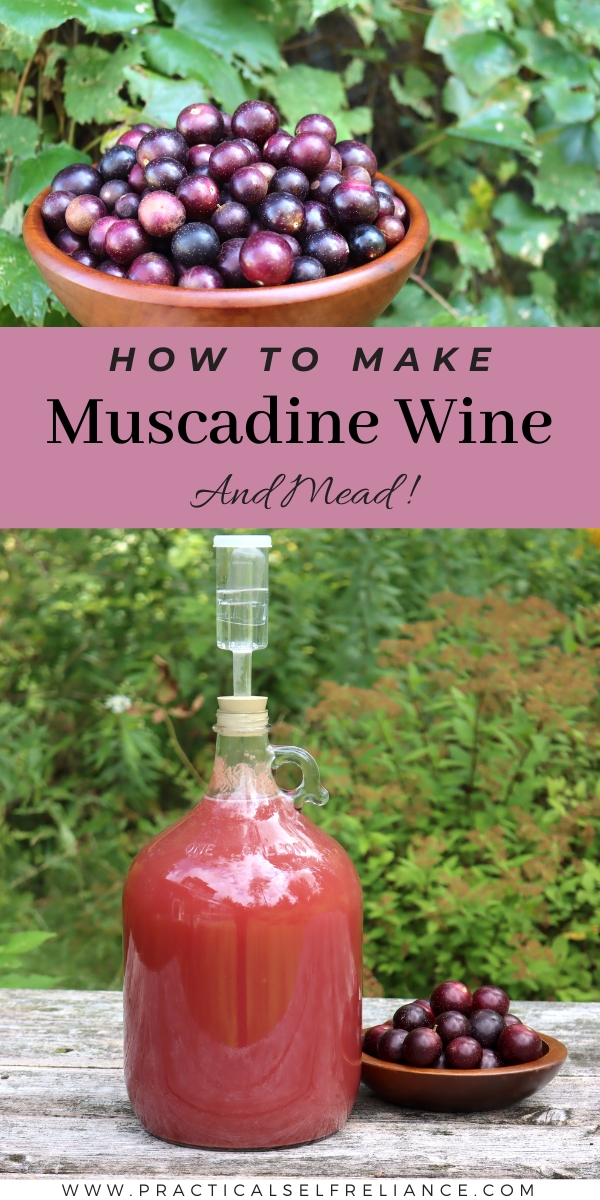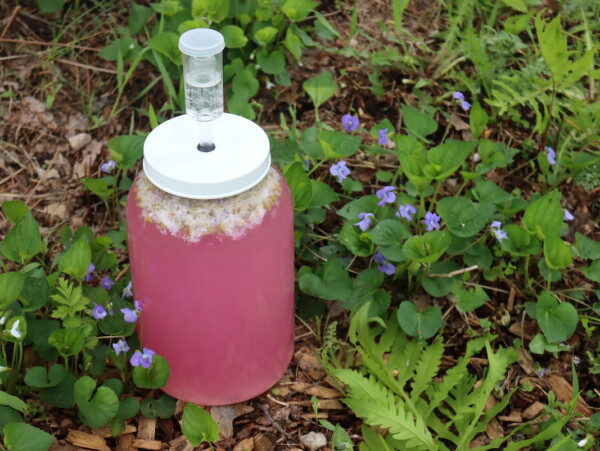Affiliate disclosure: This post may contain affiliate links. Please see our Privacy Policy.
Muscadine wine is known to be a lovely, sweet wine to be sipped on during the summer or fall. It can be enjoyed as a dessert wine or made drier with stronger yeast strains. Use honey instead to make a sweet muscadine mead.
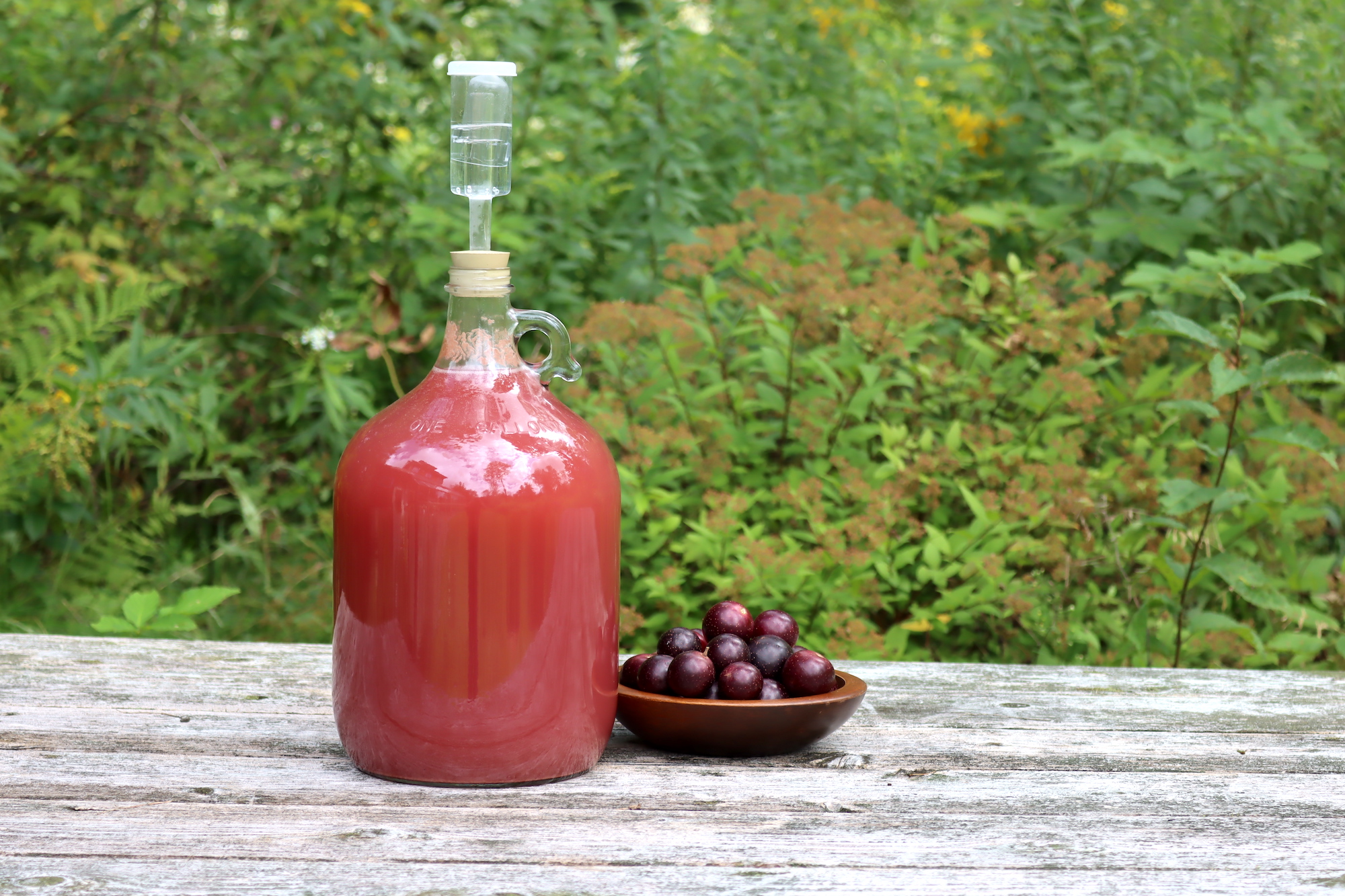
Muscadine grapes aren’t as widely known as regular grapes since they aren’t often commercially grown, but they are a true delight if you can source them.
Muscadine grapes possess a texture much softer than regular store-bought grapes and wild grapes, and the taste is much sweeter. This flavor comes at a cost though — the skin is tougher and they have seeds.
Muscadine grapes tend to do well in warm humid climates, like in the South. The colors can range from green to purple or even deep golden.
The harvest season of the little-known muscadine depends on the state you live in but typically falls somewhere in the span of the last week in July to early October. They’re found easily in the Southeast parts of the U.S. and as far north as North Carolina and Kentucky. Some muscadines have even made it as far westward as East Texas.
There are many varieties of muscadine around, scuppernong being one of them. Scuppernong grapes tend to have a greenish bronze coloring and taste a little more tart.

Muscadine and scuppernong wine actually have a long history in America with such wines stretching back into the 1800’s. Apparently, a scuppernong wine named Virginia Dare was a very popular wine in early America — until prohibition that is.
Whether you use scuppernong grapes or regular muscadines, muscadine wine is a sweet and delightful beverage to be enjoyed.
When making muscadine wine, you’ll follow the same simple steps as with making any small-batch country wine.
The grapes will be gently mashed and included in the primary ferment with a little sugar and some winemaking additives. After a week, you’ll siphon it to a new vessel for secondary and add the rest of the sugar.
Here the wine will ferment at a slower tempo for 6 weeks to 6 months, hopefully in a dark and cool environment. After secondary, the wine is bottled and allowed to mature for a few weeks to a few months before opening.
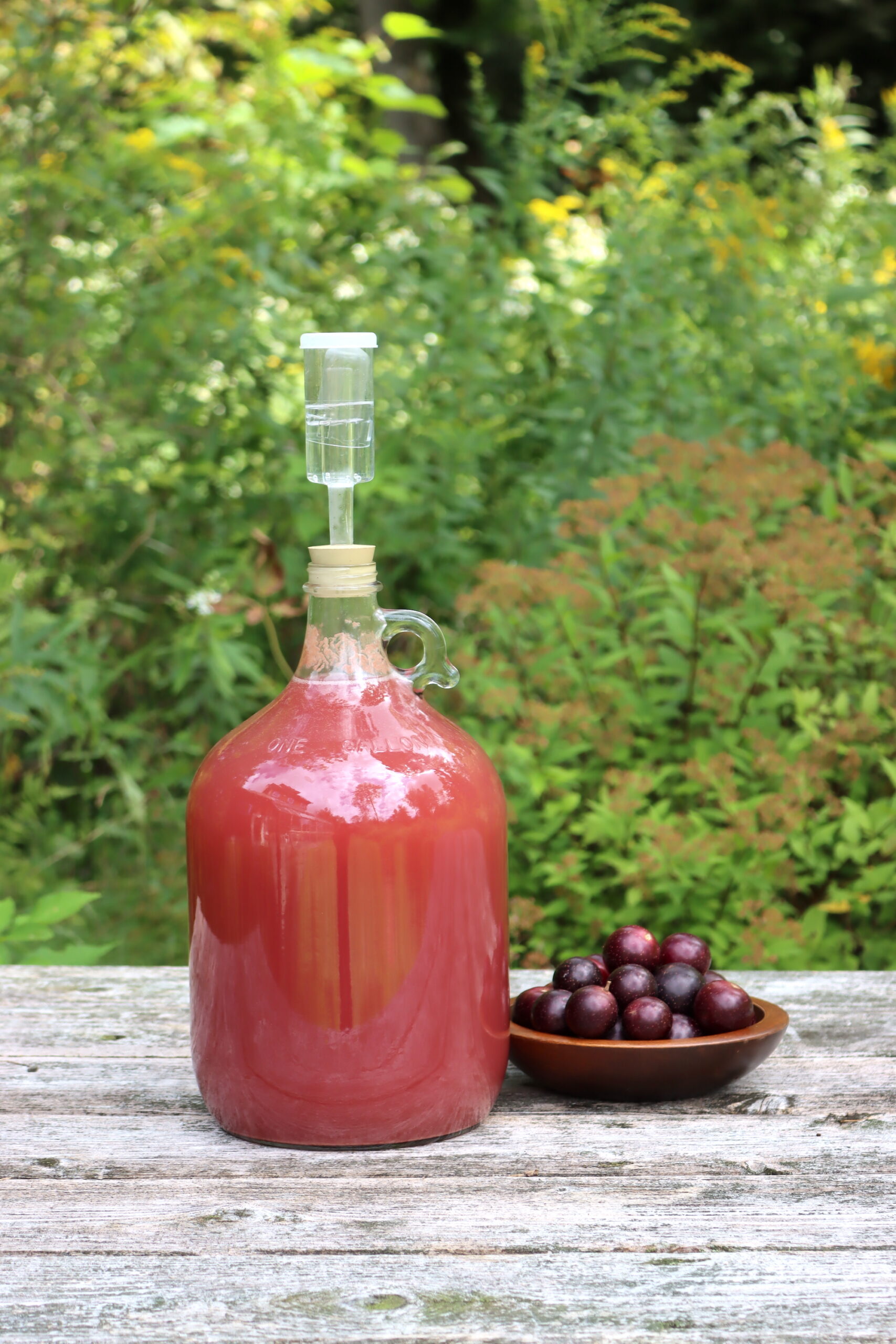
I’ve written this as a simple recipe, assuming the reader’s already familiar with common winemaking terms and practices. If this is your first batch (or you just need a quick brushup on anything), these introductory articles will be quite helpful to you:
- Beginners Guide to Making Fruit Wines will guide you through each step in the winemaking process bit by bit.
- How to Make Mead (Honey Wine) will be pretty much the same, but includes some important differences when working with honey instead of sugar.
- Equipment for Winemaking contains information on all the equipment necessary to make your first batch (other than your ingredients).
- Ingredients for Winemaking will tell you all about the required ingredients and possible substitutions.
- Yeast for Winemaking may seem vast and complicated seeing as there are so many strains available to choose from. Finding the right one is pretty important and this will simplify it into straightforward terms.
Ingredients for Muscadine Wine
To make muscadine wine, you’ll need only about 5 ingredients in addition to your muscadines.
If you’re curious to understand more about what each of these ingredients does in the winemaking process, I recommend you read this piece on winemaking ingredients to learn what each of these things does or what can be substituted for them in a pinch.
For a one-gallon batch of muscadine wine, you will need:
- 4 to 4 ½ lbs muscadines, destemmed
- 2-½ pounds sugar (5 cups)
- 1 tsp Yeast Nutrient
- ½ tsp Acid Blend
- ½ tsp Pectic Enzyme
- Wine yeast
- Water, to fill
Several of these ingredients can be bought together in a small kit, although you don’t need the wine tannin for this recipe as muscadines have plenty of tannins all on their own.
You will however need about a ½ tsp of acid blend to keep the environment nice and acidic for the yeast (and to give wine balance) as well as a ½ tsp pectic enzyme to help the wine clear.
Besides the acid blend and pectic enzyme, you’ll also need a packet of yeast nutrient.
In terms of the muscadines, you’ll want to gather between 4 to 4-½ pounds. For the sugar, you’ll also want a decent amount — about 5 cups — although it will be added at different intervals during the winemaking process. (Adding the sugar all at once can stunt the yeast.)
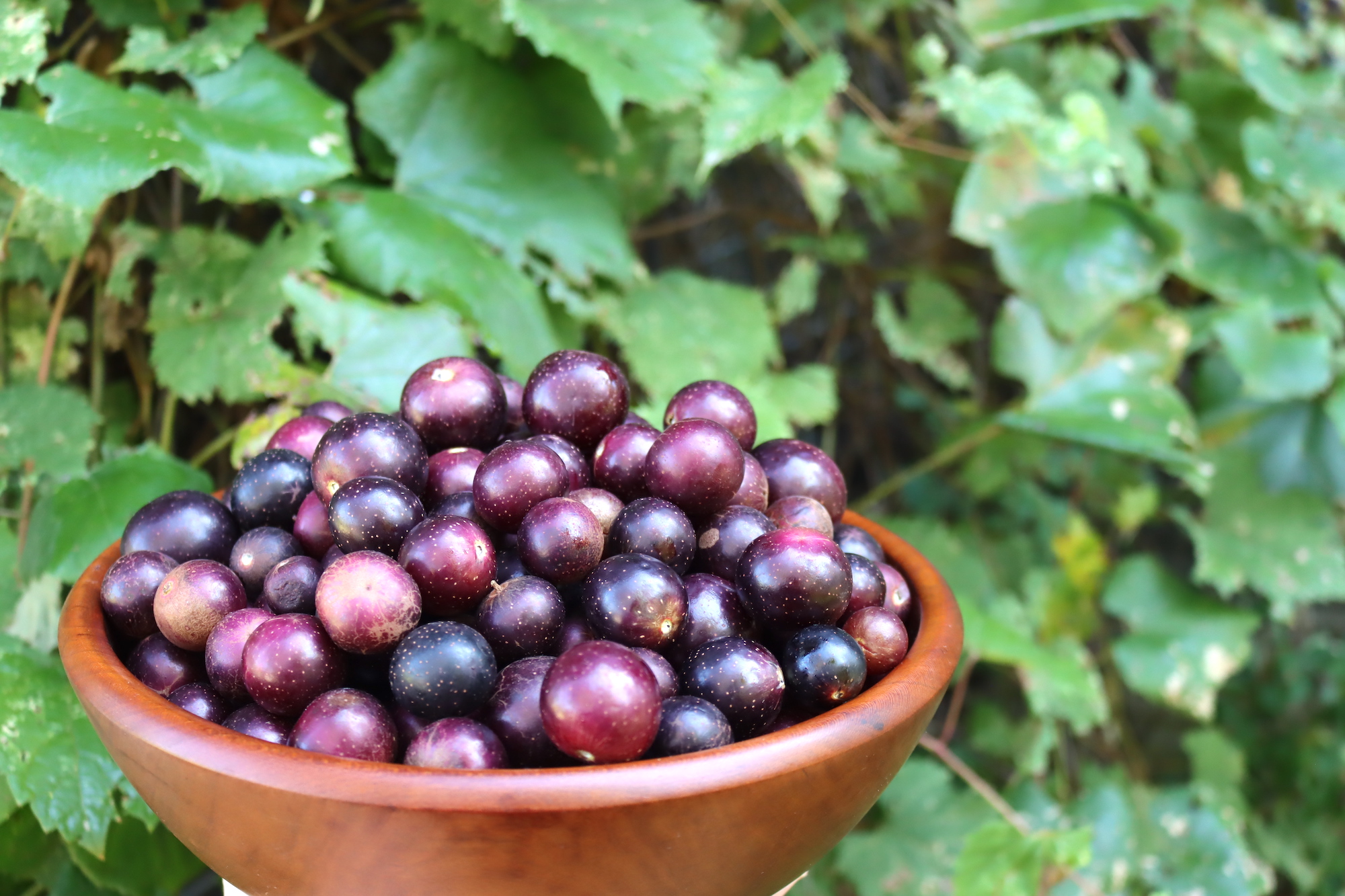
Yeast for Muscadine Wine
As to your wine yeast, Red Star Pasteur Blanc is one often recommended for muscadine wine.
Red Star Premier Blanc is a neutral wine yeast used for dry white wines and meads. It has an alcohol tolerance to 15% and a temperature range between 59°F to 86°F.
If using the scuppernong type of muscadines, Lalvin K1V-1116 is highly recommended. Lalvin K1-V1116 is a very dependable yeast, known for adding nice fruity-floral esters to wine. It has a high alcohol tolerance (up to 18%) and a wide temperature range (50°F to 95°F).
Another dependable yeast many go with when making muscadine wine is Lalvin EC-1118. Lalvin EC-1118 is a neutral-tasting champagne yeast with a higher alcohol tolerance (15% to 18%) that can result in dryer wine, but this can be accommodated by backsweetening. Preferred temperature range of 59°F to 86°F.
If making muscadine mead, you’ll want to substitute honey for sugar. About 3 lbs (1 quart) will be needed for a one-gallon batch.
Winemaking Equipment
Alongside these winemaking ingredients, this standard winemaking equipment will be required as well:
- One-Gallon Wide Mouth Fermentation Vessel for the primary fermentation
- One Gallon Glass Carboy (often sold as a kit with a rubber stopper and water lock together)
- Rubber Stopper and Water Lock (if not included above)
- Brewing Siphon
- Wine Bottles or Flip-top Grolsch bottles
- Bottle Corker and clean, new corks for bottling
- Brewing Sanitizer
Making Muscadine Wine
Once ready to make muscadine wine, you’ll need to start by mashing the grapes (be sure you have destemmed them first). If desired, you can place the mashed grapes in a brew bag.
It is possible to over-process grapes, so don’t blend them or anything, just crush them with your hands. Over-processing grapes will crush the seeds, adding bitter flavors to your wine.
Move the crushed grapes to your primary fermentation vessel. A wide-mouth carboy is a nice one to choose.
Bring a few quarts of water to boil on the stovetop and stir in just a ½ pound of the sugar (1 cup). Once dissolved, pour this into your fermentation vessel covering your grapes.
Let the mixture cool. Add the acid blend, pectic enzyme and yeast nutrient next. The wine yeast should be added last.
Don’t add your wine yeast directly. Rehydrate it first in a bit of room temperature water so it blooms. Wait 10 minutes and then add to your carboy.
Finish by topping with enough water to leave 2 inches of headspace and seal with a water lock. Ferment here in primary for 5 to 7 days.
During this primary ferment, you should see the most active fermentation. Lots of bubbling will be seen in a day or two. This should begin to slow towards the end of the week.
Siphon to a new container and strain out the grapes, being careful not to stir up the sediment. The sediment will cause off-flavors in your finished wine.
After racking the wine to a clean container for secondary, add the remaining 2 lbs of sugar (4 cups). This should be done by dissolving the sugar in water as before and adding this to your wine once cool. Top with enough water to bring the wine up to the neck of the carboy and seal with a water lock.
Let the mixture ferment in secondary for at least another 4 weeks.
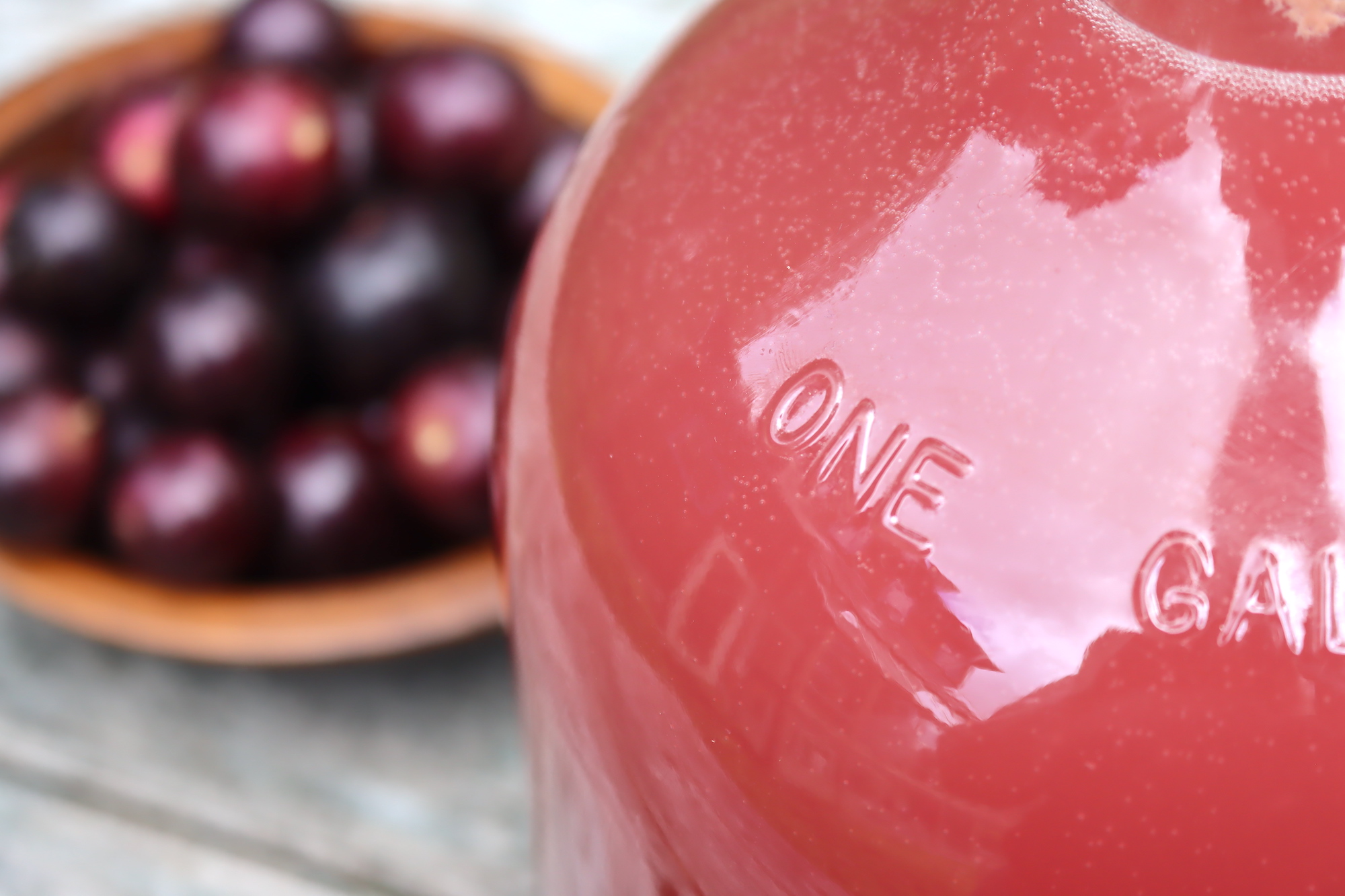
If you’re making muscadine mead, also called pyment or grape melomel, the time needed in secondary will be longer. Mead typically needs to spend 2 to 6 months in secondary since honey is less digestible than regular sugar is for the yeast.
Sample your wine at the end of secondary. It should taste balanced although it is unfinished. If it’s too dry, this is the point where you’ll back sweeten. Always rack to a new container for backsweetening.
To backsweeten, either stabilize your wine before adding sugar or add sugar and put it back into ferment until all signs of activity have died out (about a month). You do not want to bottle wine that still has an active fermentation happening, as the resulting pressure can cause bottles to burst.
This is why many people choose to stabilize their wine before backsweetening. To stabilize the wine, add 1 Campden tablet and ½ teaspoon potassium sorbate, then wait 24 to 48 hours to ensure the yeast has died off before adding any sugar. Sugar should be added by making a simple syrup of equal parts water and sugar.
Put back into ferment for another week before bottling to be sure the ferment does not restart.
Once ready, bottle the wine, seal with corks and allow the wine to bottle-age a little before drinking. You can drink it as soon as a month, but the taste will improve if you can wait for 6 months.
Ways to Preserve Muscadines
Have more grapes to spare. There are more ways than winemaking to preserve muscadine grapes!
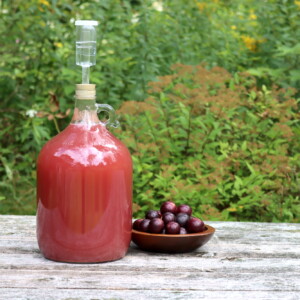
Muscadine Wine (& Mead)
Equipment
- Air Lock & Stopper
Ingredients
- 4 to 4-½ lbs muscadines, destemmed
- 2-½ pounds Sugar, about 2 cups per pound
- 1 tsp yeast nutrient
- ½ tsp acid blend
- ½ tsp Pectic Enzyme
- 1 packet wine yeast, see note
- Water, to fill
- Optional ~ Campden Tablet and Potassium Sorbate for Stabilizing, I do not use these
Instructions
- Begin by crushing the destemmed muscadines by hand.
- Move crushed muscadines to a wide-mouth carboy.
- Heat a few quarts of water and add 1 cup of sugar. Stir until dissolved.
- Once cool, add to carboy.
- Add the acid blend, pectic enzyme and yeast nutrient next. The wine yeast should be added last.
- Rehydrate yeast in some room temperature water for 10 minutes before adding.
- Add yeast and top with water to leave 2 inches of headspace.
- Seal with a water lock and ferment in primary for 5 to 7 days.
- Siphon to a clean carboy, straining out the grapes and leaving the sediment behind. Add the remaining 2 cups of sugar at this point (do so by dissolving sugar in water before adding).
- Add enough water to bring the level up to the neck of the carboy and seal with a water lock.
- Ferment in secondary for at least 6 weeks. (Time spent in secondary will be longer for mead.)
- At the end of secondary, sample wine and adjust if needed. (See notes for info on backsweetening.)
- Bottle the wine and seal it with wine corks
- Allow to age at least 1 month before drinking and 6 months for best results.
Notes
Muscadine Mead
To make muscadine mead (or muscadine pyment) you will need about 3 lbs (1 quart) of honey to make a one-gallon batch. The time spent in secondary will be longer than for sugar-based muscadine wine, as honey takes longer for the yeast to digest than sugar. Recommended time spent in secondary for mead is 2 to 6 months.Yeast
For muscadine wine, there are a lot of yeast options available to you. I recommend looking for a wine yeast with moderate alcohol tolerance. Some good yeast choices include Red Star Pasteur Blanc, Lalvin EC-1118 and Lalvin K1-V1116 (especially for scuppernong grapes). See notes within the article for the specific qualities of each yeast.Stabilizing and Back Sweetening
If the wine tastes somewhat too dry at the end of secondary, backsweetening can counteract this. Rack to a clean container first to avoid stirring up any sediment. Next, stabilize the wine by adding 1 Campden tablet and ½ teaspoon potassium sorbate. Wait 24 to 48 hours to ensure the yeast has died off before adding any sugar. Sugar should be added in the form of a simple syrup made from equal parts water and sugar. Tastes will vary, but ½ cup sugar is a good place to begin. Once added, put back into ferment for a week before bottling to ensure fermentation does not restart. For more info on backsweetening and stabilizing, see notes within the article.Nutrition
Nutrition information is automatically calculated, so should only be used as an approximation.
Winemaking Recipes
Now that batch is done, you need a new project to work on. I have plenty more fruit, flower and even a few veggie wines to try next!
